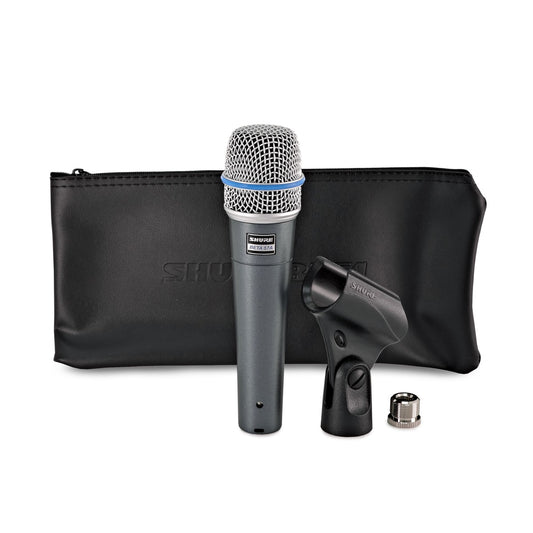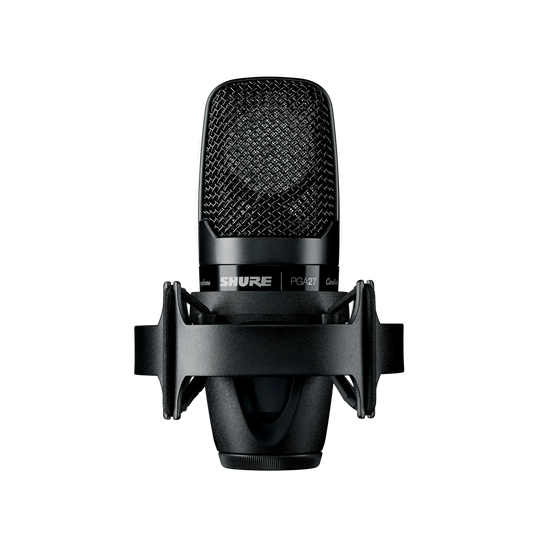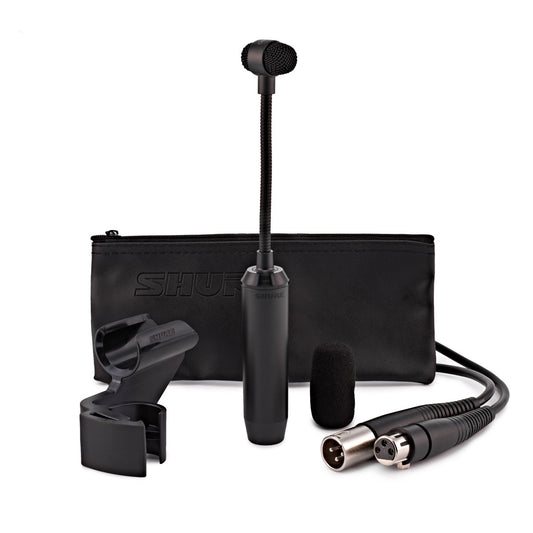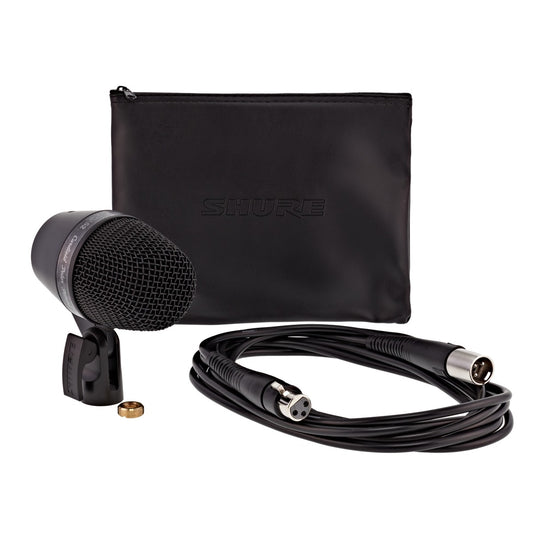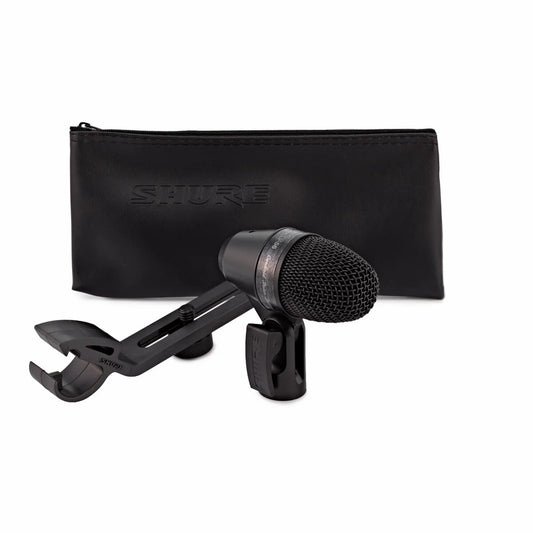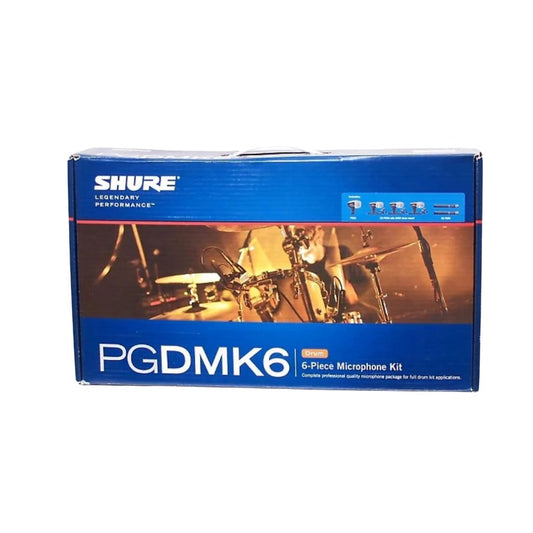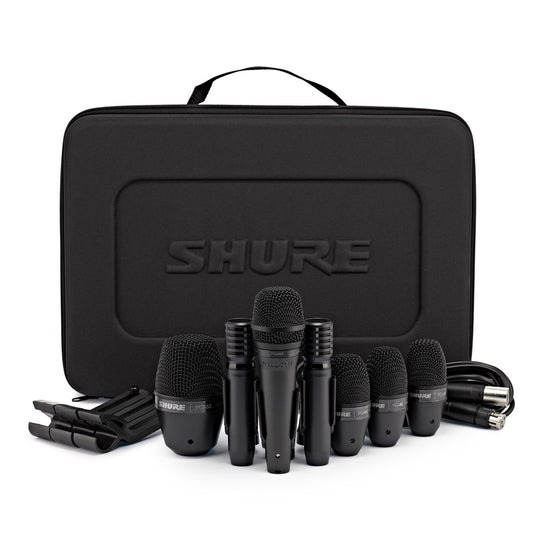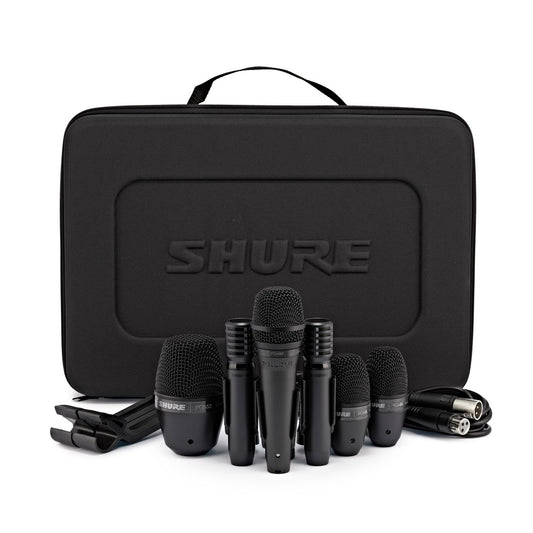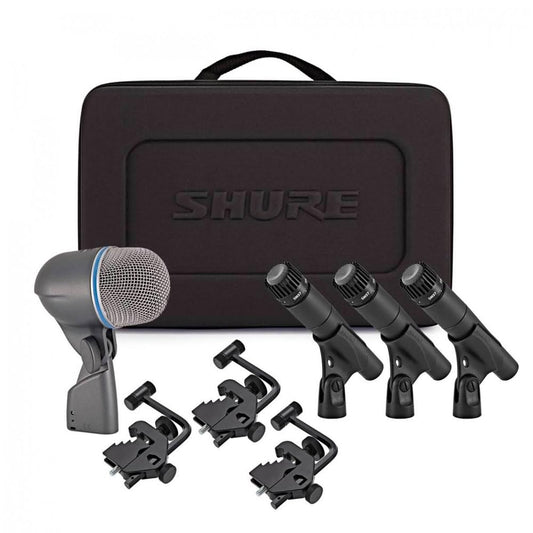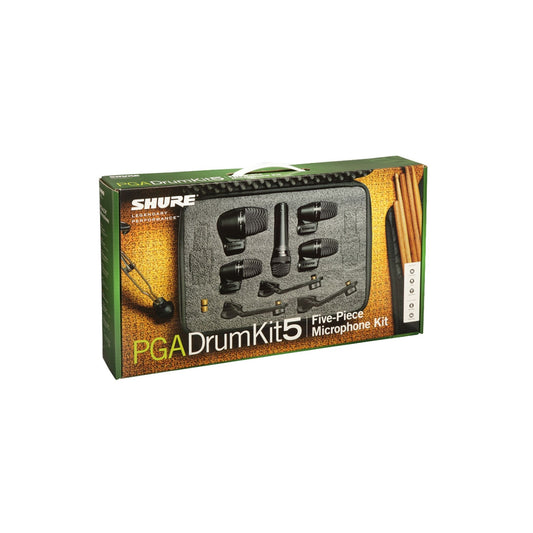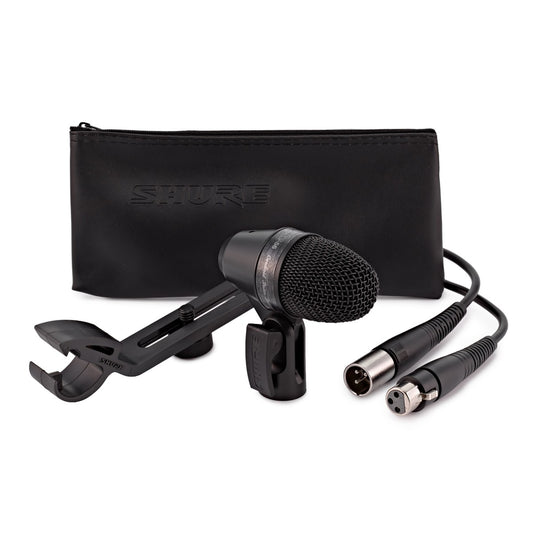Micro Trống
Micro Trống
Micro Trống - Drum Micro. Cách Tìm Bộ Mic Trống Tốt Nhất.
Có thể nói, một trong những yếu tố phân biệt độc đáo nhất để nhận biết âm nhạc của một ban nhạc chính là chất lượng ghi âm của bộ trống. Với khả năng phát ra nhiều dải tần số, bộ trống cách âm tạo ra những thách thức khi ghi âm mà người chơi cần đối mặt.
Dĩ nhiên, để thu âm âm trống với chất lượng cao, bạn có thể sử dụng các micro cao cấp. Tuy vậy, sự kết hợp của micro đặc thù và micro cực trở sẽ mở rộng không gian sáng tạo hơn bất cứ thứ gì khác.
Bộ trống không chỉ là một tổ hợp các thành phần bao gồm trống, cymbal và hi-hat, mà chúng còn đóng góp vào sự hòa quyện của âm trống tổng thể. Hơn nữa, không thể phủ nhận rằng một chiếc micro chỉ có thể phục vụ một trống vào một thời điểm, và đương nhiên, giá của chiếc micro phòng thu ưa thích cũng tăng đáng kể.
Đây chính là lúc mà bộ micro âm trống thể hiện tầm quan trọng. Nhìn chung, bộ micro âm trống bao gồm các micro riêng biệt cho snare, tom, kick và cymbal. Thậm chí một số người chơi trống thích có micro riêng cho hi-hat, điều này có sẵn trong một số bộ trang bị.
Việc đầu tư vào một bộ micro âm trống tốt có thể tốn nhiều kinh phí đối với những người có ngân sách hạn hẹp. Tuy nhiên, từ góc độ lâu dài, điều này có thể giúp bạn tiết kiệm nhiều tiền.
Bài viết này sẽ chia sẻ kiến thức và kinh nghiệm đã tích luỹ với bạn. Trong quá trình đó, hy vọng rằng tôi có thể hỗ trợ bạn trong việc đưa ra những quyết định tốt nhất về micro và quá trình ghi âm âm trống tổng thể.
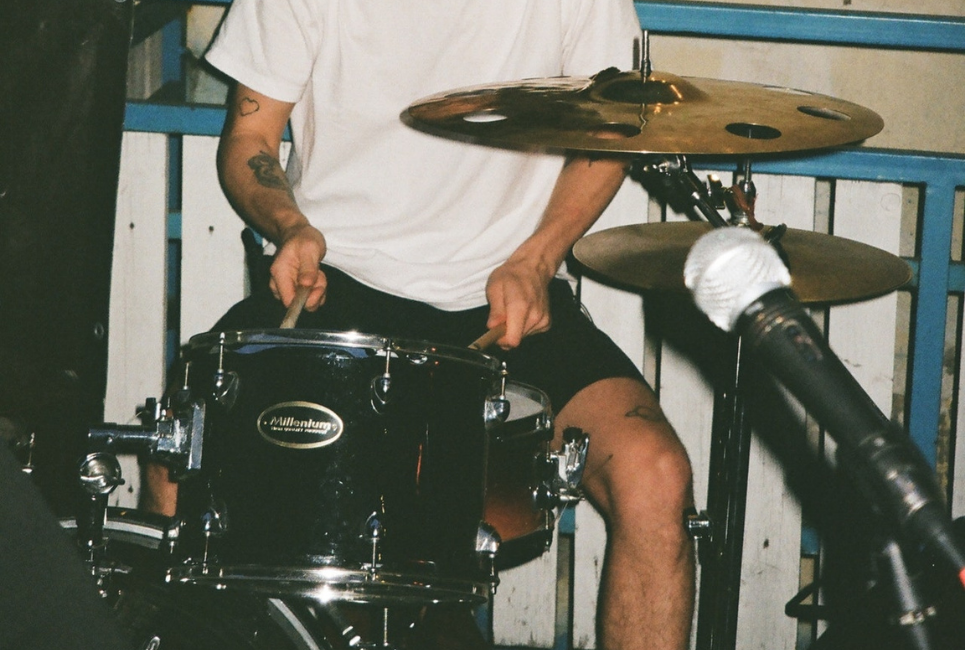
Micro Trống là gì và tại sao chúng ta cần chúng?
Micro cơ bản là một bộ chuyển đổi, giúp biến đổi rung động âm thanh thành tín hiệu điện tử. Nói một cách khác, nhiệm vụ của nó là chuyển đổi năng lượng từ sóng cơ học thành tín hiệu có thể ghi lại. Sự ứng dụng của micro lan rộng qua nhiều lĩnh vực khác nhau như ghi âm âm nhạc, truyền thông số, y học, kỹ thuật dân dụng và nhiều ứng dụng khác.
Về phân loại cơ bản, micro có thể chia thành các loại sau:
Micro đa hướng: Loại này có khả năng thu âm âm thanh từ mọi phía do mẫu hình thu của nó. Chủ yếu được sử dụng trong phòng thu để ghi lại giọng nói hoặc âm nhạc.
Micro một chiều: Loại này chỉ có khả năng thu âm từ một hướng cụ thể. Mẫu hình thu của nó được thiết kế để chỉ nhận tín hiệu khi nguồn âm thanh đặt ngay phía trước micro. Chúng thường được sử dụng trong phỏng vấn hoặc để loại bỏ tiếng ồn ở những môi trường nhiễu.
Micro hai chiều: Còn gọi là micro hình số tám, loại này được thiết kế để thu âm từ phía trước và phía sau. Thường được sử dụng trong các cuộc trò chuyện giữa hai người khi muốn ghi lại cả hai phía với mức độ cân bằng.
Micro gắn trên người: Loại này thường được gọi là micro cài áo hoặc micro cá nhân. Chúng có thể kẹp vào cà vạt, cổ áo hoặc quần áo. Thường sử dụng trong phỏng vấn truyền hình, sự kiện công cộng và biểu diễn trực tiếp.
Micro không chỉ là một công cụ thu âm, mà còn mang trong mình nhiều loại và ứng dụng khác nhau tùy theo mục đích sử dụng.
Lịch sử sơ khai của micro.
Nhiều người cho rằng nguồn gốc của chiếc micro xuất phát từ Alexander Graham Bell, nhà phát minh ra điện thoại. Phiên bản đầu tiên của điện thoại sử dụng một cây kim đặt trong nước để ghi nhận rung động của giọng nói. Sự biến đổi trong chất lỏng sẽ điều khiển dòng điện truyền đến máy thu ở phía đối diện.
Bước tiến quan trọng tiếp theo trong việc phát triển micro đến từ Emil Berliner vào năm 1877. Ông đã tạo ra micro nút carbon đầu tiên trên thế giới bằng cách sử dụng màng ngăn điện dẫn. Mô hình này mang lại hiệu suất vượt trội so với mô hình sử dụng nước của Bell, nó có sự tương đồng với các micro hiện đại mà chúng ta sử dụng ngày nay.
Thời kỷ kỹ thuật số của micro được Sony khởi đầu khi họ giới thiệu Thiết bị âm thanh PCM-1 mã hóa PCM cho người tiêu dùng lần đầu tiên vào năm 1977. Thời kỳ này trong lĩnh vực ghi âm đã thấy sự ra đời của Băng âm thanh kỹ thuật số (DAT) dành cho người tiêu dùng.
Các thiết bị DAT này có khả năng ghi ở tốc độ lấy mẫu là 48 Khz và 44,1 Khz. Sau đó, vào đầu những năm 1990, máy ghi âm kỹ thuật số nhiều kênh nhanh chóng thu hút sự chú ý do có giá cả tương đối thấp.
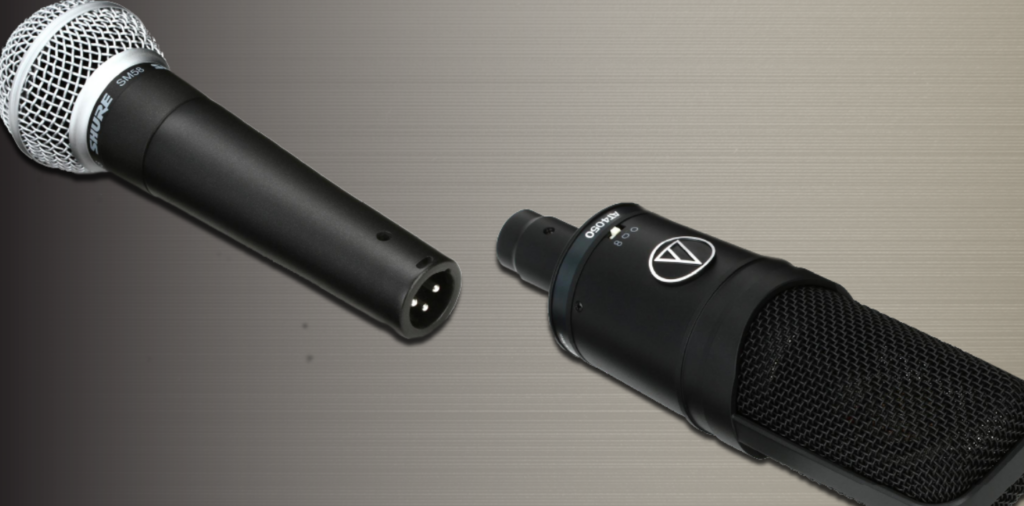
Những điều cần tìm khi mua micro.
Mic trống thường có 3 loại : động, tụ điện và ruy băng. Dưới đây là một số điểm để tìm hiểu từng loại:
| Mic Động | Mic Tụ | Mic Ruy Băng |
| Có thể chịu được âm thanh lớn mà không gây méo tiếng | Dễ bị biến dạng từ các nguồn âm thanh lớn | Rất dễ bị biến dạng do tiếng ồn lớn |
| Ghi lại cường độ tổng thể với ít chi tiết hơn | Ghi lại nhiều chi tiết, đặc biệt là ở những phần tinh tế (chẳng hạn như chi tiết trang trí trên cymbal | Ghi lại ít chi tiết hơn đáng kể do kiểu định hướng của chúng |
| Phản hồi khá chậm, có thể nén đòn tấn công của trống | Phản ứng dễ dàng và tái tạo chính xác hơn sự thể hiện của đòn tấn công của trống | Có xu hướng loại bỏ phần cao cấp, đặt chúng ở giữa (và cũng làm dịu đi một số đòn tấn công của trống) |
Tiếng trống bẩm sinh đã to, việc quan trọng là cần ghi nhớ ranh giới mà micro bắt đầu bị méo tiếng. Bạn có thể dễ dàng mua thiết bị trực tuyến hoặc tại cửa hàng nhạc truyền thống yêu thích, để theo dõi mức âm thanh của mình bằng đơn vị đo dB.
Máy đo SPL (Sound Pressure Level - mức áp suất âm thanh) không đòi hỏi nhiều chi phí. Tuy vậy, nó mang lại rất nhiều lợi ích trong quá trình ghi âm, vì vậy bạn chắc chắn cần mua một cái.
Sự khác biệt cơ bản giữa micro tụ điện và micro động là gì?
Dựa trên ứng dụng, bạn có thể cần sử dụng micro điện dung hoặc micro động khi thực hiện. Dưới đây là một số điểm chính để làm rõ sự khác biệt quan trọng giữa hai loại micro này:
• Micro động thường ghi âm hiệu quả hơn cho các âm thanh lớn như tiếng trống và guitar, đặc biệt là cho các nhạc cụ trực tiếp, trong khi micro tụ điện thường được ưa chuộng để ghi lại âm thanh tinh tế như giọng hát trong phòng thu, đặc biệt trong môi trường thu âm phòng.
• Micro động không đòi hỏi nguồn điện bổ sung, trong khi micro tụ điện cần nguồn điện.
• Micro động thường có độ nhạy thấp và ngưỡng khuếch đại cao hơn, giúp chúng thu nhận tín hiệu mạnh mẽ mà không gây hại cho bộ loa. Trong khi đó, micro tụ điện thường có độ nhạy cao hơn, có thể dẫn đến biến dạng khi tín hiệu quá mạnh.
• Micro động thường có khả năng thu âm dải tần số rộng hơn, trong khi micro tụ điện mang lại sự chính xác và động lực cao hơn.
• Micro động thường có đặc điểm thụ động kết thúc với trở kháng rất thấp, góp phần tạo màu sắc âm thanh đặc biệt. Trong khi đó, micro tụ điện thường không tạo ra nhiều hoặc không có ảnh hưởng màu sắc trong tín hiệu âm thanh.
Các lợi ích của việc sử dụng mic trống.
Xây dựng thói quen tập luyện bằng việc ghi lại các buổi luyện tập của bạn và sau đó phân tích chúng để tìm ra điểm cần cải thiện. Bằng cách sử dụng micro để ghi âm bộ trống, bạn sẽ có khả năng theo dõi âm thanh một cách chặt chẽ, từ đó dễ dàng khắc phục những hạng mục yếu kém.
Hiện nay, có nhiều phương pháp để bạn ghi âm tiếng trống với chất lượng âm thanh tốt. Ngay cả chiếc điện thoại cũng có thể ghi lại clip trống có chất lượng tiêu chuẩn để chia sẻ trực tuyến. Tuy nhiên, trong trường hợp bạn Ưu điểm tiên chất lượng như trong phòng thu, bạn cần sử dụng đúng công cụ. Đối với các bản trình diễn hoặc âm nhạc chuyên nghiệp, không có sự thay thế nào thực sự hiệu quả hơn việc sử dụng micro.
Sự chi tiết và độ phong phú âm thanh mà micro tụ điện đơn giản có thể bắt được là không thể so sánh. Thậm chí cả bộ trống điện tử cũng không thể tái hiện đầy đủ kết quả thú vị trong việc ghi lại các phần mềm và khoảnh khắc yên tĩnh trên bộ trống.
Nhiều người chơi trống thường tự đặt câu hỏi liệu có nên thu âm trực tiếp từ bộ dụng cụ của họ trong các sự kiện nhỏ hơn. Dù việc tạo ra một bộ trống không phải lúc nào cũng cần thiết hoặc thực hiện được trong các buổi biểu diễn nhỏ, bạn hãy thử làm điều đó nếu có cơ hội. Kết quả thu được khi truyền âm trực tiếp đến hệ thống âm thanh và sự hài hòa toàn cảnh của ban nhạc sẽ dễ dàng quản lý hơn.
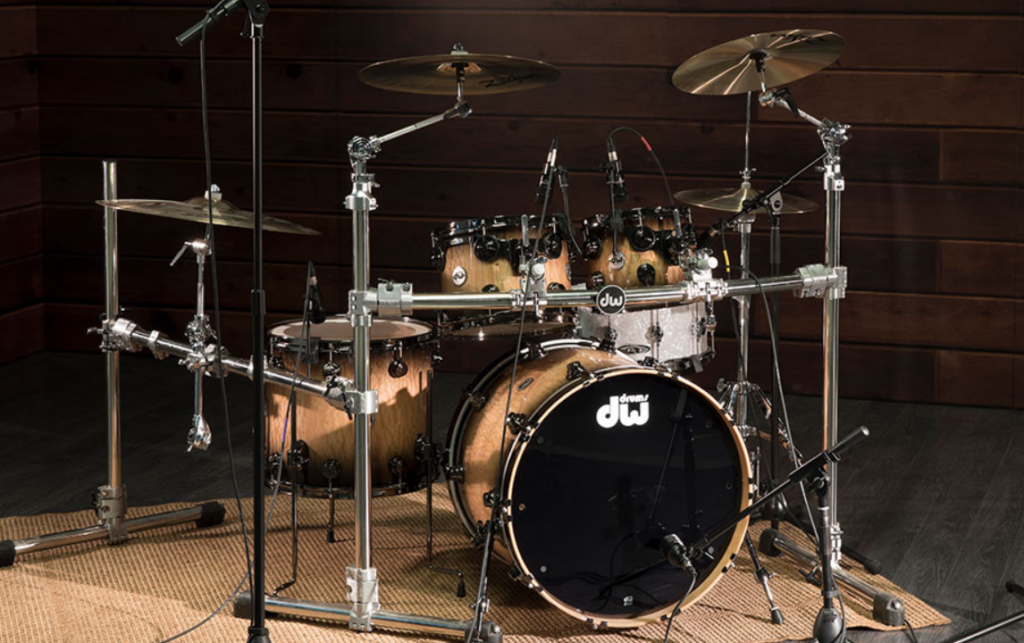
Nhược điểm khi sử dụng mic trống.
• Đối với từng nhạc cụ trong bộ trống, bạn cần micro cụ thể. Mỗi nhạc cụ mang một sức hút riêng trên dải tần số, vì vậy việc ghi âm chúng với độ trung thực cao đòi hỏi sự sử dụng các loại micro khác nhau. Ví dụ, điều chỉnh âm thanh của hi-hat bằng micro phù hợp hơn với việc điều chỉnh cho trống kick có thể dẫn đến mất đi tần số cao bạn cần. Việc phát triển tai và kiến thức về cách đánh trống có thể mất nhiều năm cho người chơi trống, thậm chí sau đó, quá trình học vẫn không có hồi kết rõ ràng.
• Việc điều chỉnh âm thanh cho phòng thu ghi âm có thể gặp khó khăn. Nhiều người mới bắt đầu không chú ý đúng mức đến môi trường trong phòng hoặc các yếu tố biến đổi cần thiết để ghi lại tiếng trống sống động và đầy đủ. Ghi trống trong buổi biểu diễn trực tiếp thường dễ dàng hơn nhiều so với phiên thu âm trong phòng, vì bạn không cần quan tâm đến không gian của phòng.
• Tìm vị trí phù hợp cho micro có thể mất thời gian và công sức. Đặt vị trí và góc của micro một cách thích hợp có thể là một nhiệm vụ đầy mệt mỏi. Các kỹ thuật xử lý âm EQ chỉ có thể tác động một phần đối với âm thanh sau khi bạn đã thu âm, vì lý do này, việc thiết lập âm thanh đúng từ ban đầu trở nên cực kỳ quan trọng.
• Tránh hiện tượng hủy pha có thể vô cùng khó khăn. Hiện tượng hủy pha trong quá trình ghi âm trống xảy ra khi hai micro thu âm cùng một âm thanh nhưng không đồng bộ với nhau. Khi hai tín hiệu không đồng bộ ở khoảng cách 180 độ, chúng sẽ tương tác với nhau, gây ra tín hiệu yếu hoặc mất mát.
• Việc đầu tư vào một bộ micro chất lượng có thể đòi hỏi sự đầu tư lớn. Lí thuyết có thể bạn chỉ sử dụng một micro duy nhất để thu âm toàn bộ bộ trống, nhưng kết quả cuối cùng có thể không đạt yêu cầu của bạn. Hầu hết các bộ micro trống được sản xuất không bám sát vào ngân sách, những phiên bản cao cấp có thể có giá hàng nghìn đô la.
Tiêu chí đánh giá về bộ mic trống là gì?
• Bộ sản phẩm Mic: Khía cạnh này của bộ mic trống không thể bỏ qua, bởi vì nó có ảnh hưởng quan trọng nhất đến âm thanh. Tùy thuộc vào bộ dụng cụ của bạn, bạn cần nắm bắt ý thức sâu sắc về số lượng micro cần thiết cho snare và trống. Nhưng điều quan trọng nhất là bạn cần xác định liệu cần micro trên cao hay không.
• Loại Micro: Dải động, tụ điện, hay dải băng... bạn sẽ chọn loại nào? Sự lựa chọn của bạn sẽ hoàn toàn dựa trên thể loại âm nhạc, phong cách chơi và dấu ấn âm thanh bạn muốn thể hiện từ bộ trống của mình.
• Chất lượng âm thanh: Yếu tố quyết định chất lượng âm thanh mà micro có khả năng tái hiện chính là loại mạch điện tử mà nó sử dụng. Các mô hình cao cấp thường có âm thanh tốt và tự nhiên hơn, trong khi các mô hình giá thấp có thể thiếu sự hoàn hảo ở một số phạm vi. Những mô hình này cũng có thể gặp vấn đề như màu sắc và nén âm thanh.
• Chi phí: Đối mặt với thực tế này. Micro tiêu chuẩn trong ngành có thể tốn một khoản tiền đáng kể. Tuy nhiên, nếu bạn xem xét từ khía cạnh dài hạn, sự đầu tư này sẽ trở nên ý nghĩa hơn. Mặc dù vậy, bạn vẫn có thể kết hợp micro trống khởi động để tạo ra một hệ thống âm thanh trống tốt.
Một số bộ mic trống nổi bật.
1. Earthwork DK7
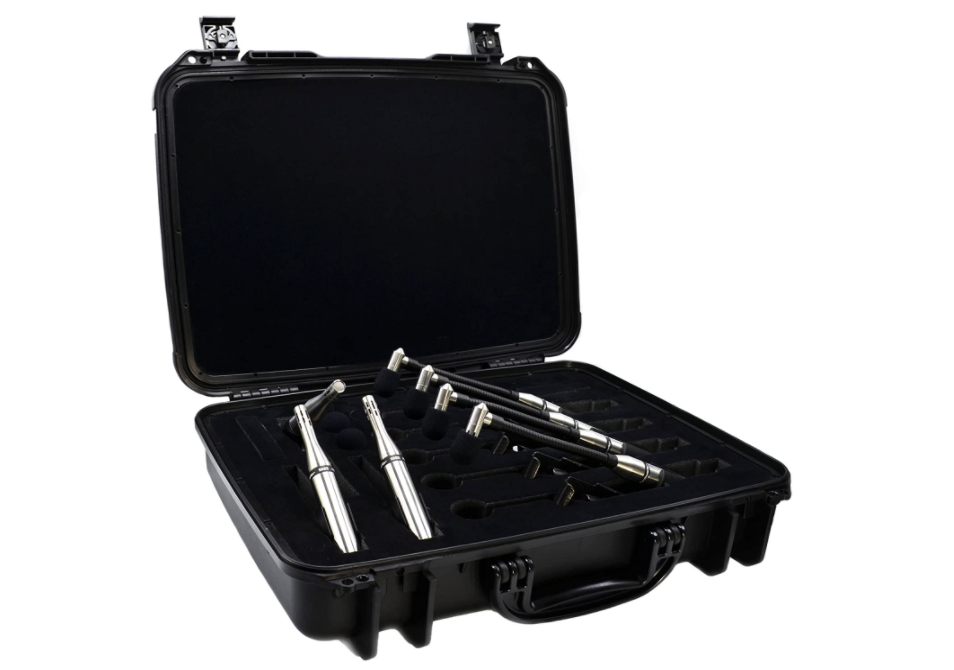
DK7 là sự lựa chọn dành riêng cho các kỹ sư phòng thu, người chơi trống biểu diễn, những người đam mê trống, mang đẳng cấp vượt trội. Khi chất lượng âm thanh và tính linh hoạt đứng đầu danh sách Ưu điểm trong quy trình ghi âm, bạn sẽ muốn sử dụng thiết bị mang lại hiệu suất tối Ưu điểm.
Bộ mic trống này bao gồm 7 micro tụ điện với độ chính xác cao trong việc thu âm. Trong bộ sưu tập, bạn sẽ có 4 micro DM20 dành cho snare và tom, hai micro trên cao SR25MP và một SR20LS.
Việc lắp đặt DM20 cực kỳ dễ dàng với cổ ngỗng tích hợp, giúp bạn dễ dàng gắn chúng lên trống. Ngoài việc tận hưởng 7 micro thú vị, bạn còn được trải nghiệm một hộp đựng đẹp mắt và cực kỳ thực tế. Tuy nhiên, bạn có thể đặt câu hỏi: "Với mức giá tương đương cả một bộ trống, liệu bộ mic này đáng đầu tư không?"
Nếu đây là lần đầu bạn đầu tư vào bộ mic, có lẽ câu trả lời là không. Nhưng với những người chơi trống và kỹ sư phòng thu có kinh nghiệm, bộ mic này có thể thay đổi trải nghiệm của họ. Earthworks luôn tập trung vào chất lượng và sự đổi mới, điều này thực sự thể hiện trong kết quả cuối cùng mà bạn có thể đạt được với bộ micro này
Ưu điểm
• Âm thanh độ trung thực cao
• Thiết kế thời trang
• Kẹp vị trí chính xác
Nhược điểm
• Giá cao hơn
• Không có tùy chọn micro động
2. Audix DP7
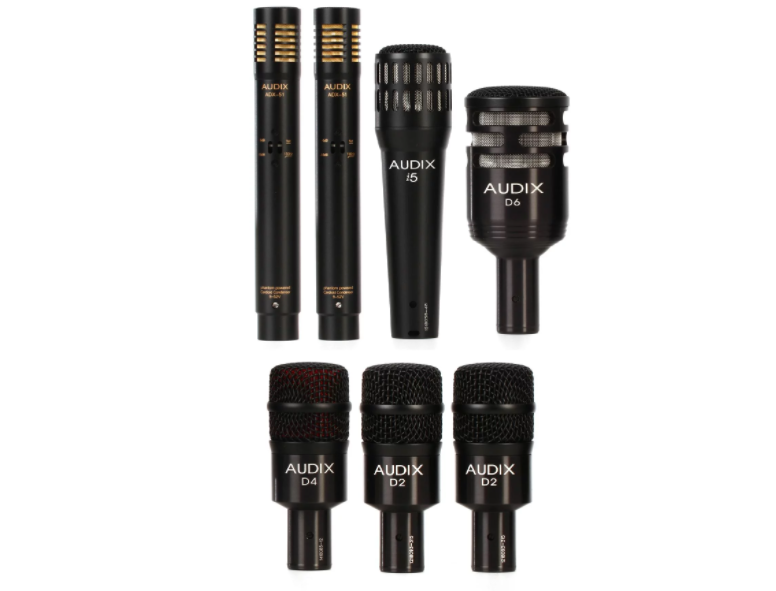
Audix cùng với Shure, đã được ghi nhận là hai trong số các thương hiệu mic trống hàng đầu trong ngành. Với dòng micro và thiết bị ghi âm ấn tượng, họ đã thu hút sự quan tâm của nhiều người hâm mộ trong những năm gần đây. Trong số những dòng sản phẩm của Audix, DP7 là một ví dụ tiêu biểu, đặc biệt thiết kế để đáp ứng nhu cầu ghi âm của đa dạng các loại tay trống.
Bộ sản phẩm bao gồm micro Audix i5 cho snare, D2 và D4 cho toms, micro D6 cho kick trống và một cặp AD51 được sử dụng làm micro trên cao. Tuy nhiên, điểm đặc biệt nổi bật của bộ sản phẩm chính là micro Audix D6 dành cho trống bass, được coi là một trong những lựa chọn phổ biến hàng đầu trong cộng đồng người chơi trống hiện nay.
Các micro D2 và D4 làm việc chính xác trong việc nắm bắt độ ấm và mạnh mẽ của tom, được đánh giá cao bởi các tay trống chơi jazz và rock. Các micro trên cao được thiết kế đặc biệt để cân bằng âm thanh tổng thể của bộ trống đã được Audix điều chỉnh EQ trước, giúp kiểm soát âm thanh một cách tỉ mỉ.
Ưu điểm
• Mic trống kick D6
• Lựa chọn linh hoạt của mics
• Chất lượng âm thanh tuyệt vời
Nhược điểm
• Khá đắt
• Giọng hát không phù hợp với mọi phong cách âm nhạc
3. Shure PGA 7
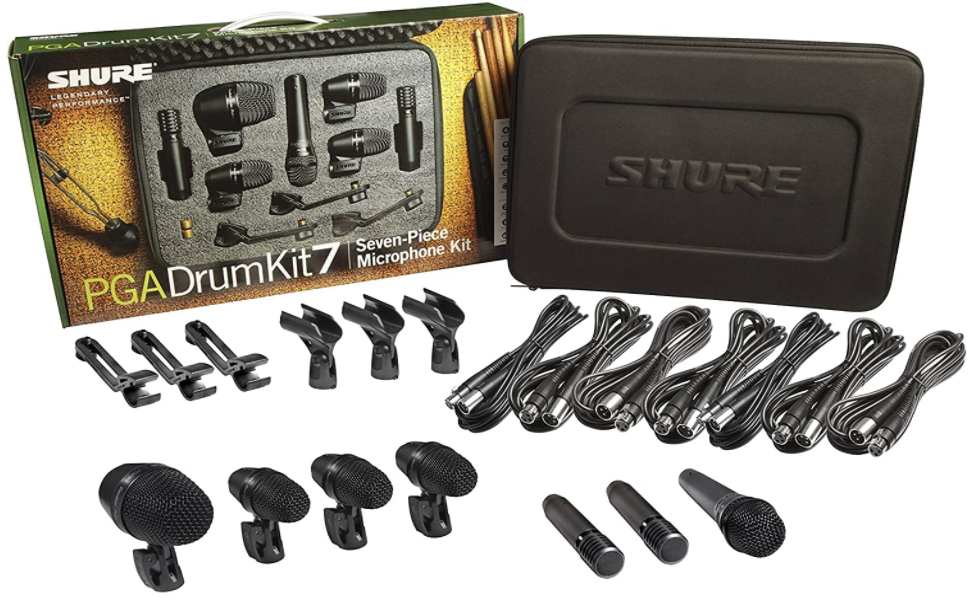
Theo quan điểm cá nhân, danh sách này sẽ không đầy đủ nếu không bao gồm ít nhất một sản phẩm đầu tàu của một thương hiệu nổi tiếng như Shure. Nhiều tay trống đã vẫy vùng với âm thanh độc đáo của những chiếc micro Shure, bởi chúng đã trở thành biểu tượng không thể thiếu trong ngành công nghiệp âm nhạc. Điều này không chỉ đề cập đến việc bộ mic này có chất lượng âm thanh xuất sắc, mà còn bởi sự hiện diện của những mẫu cổ điển, được coi là tiêu chuẩn trong nhiều phong cách âm nhạc đặc biệt.
Với bộ mic 7 món này, bạn sẽ sở hữu micro PGA52 cho trống bass, PGA56 cho tom, PGA57 cho snare và micro trên cao PGA81. PGA56 thể hiện khả năng xuất sắc trong việc tôn lên những tần số thấp của trống bass, góp phần tạo nên âm thanh mạnh mẽ. Trong khi PGA57 có đặc điểm tương đồng với Shure SM57 và tạo ra sự tươi sáng cho âm thanh phong phú của trống snare.
Nếu bạn đang có ngân sách hạn chế và đang tìm kiếm một bộ mic trống với chất lượng âm thanh tuyệt vời, thì Shure PGA Drum Kit 7 chắc chắn là sự lựa chọn không thể bỏ qua.
Ưu điểm
• Giá trị vững chắc
• Mic trống kick tuyệt vời
• Lựa chọn mic đa năng
Nhược điểm
• Có thể tìm thấy sự lựa chọn tốt hơn với giá cao hơn một chút
• Âm thanh không phải là chất lượng tốt nhất
4. AKGDrum Set Premium
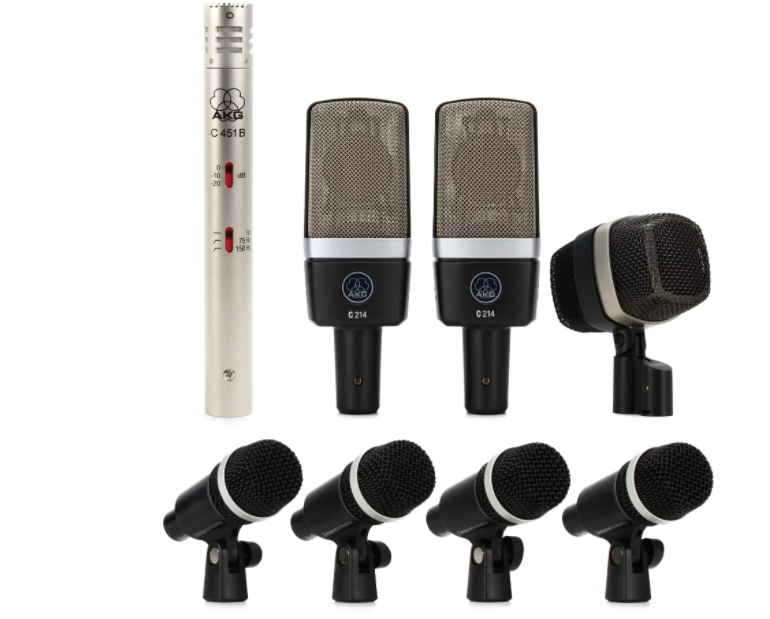
Một thuật ngữ khác mà người chơi trống thường sử dụng là "AKG". Đây là một thương hiệu đã thực sự định hình lại tiêu chuẩn kiểm soát âm thanh trống thông qua các sản phẩm như micro D12 và D112. Với bộ micro dành cho trống cao cấp của AKG, bạn sẽ sở hữu phiên bản hiện đại của mẫu D12, được gọi là D12 VR.
Ngoài ra, sản phẩm bao gồm 4 micro D40 cho snare hoặc tom, một cặp micro dạng cơ C214 và micro điện dung C451 B cho hi-hat. D12 VR tích hợp mạch hoạt động để tạo ra các hiệu ứng động từ âm thanh của trống và sử dụng nguồn điện ảo để cung cấp năng lượng cho các thành phần.
C214 là phiên bản tiếp theo của micro C414 nổi tiếng, với dải tần số và độ đa dạng tuyệt vời. Phiên bản này cải thiện một số điểm yếu của phiên bản trước đó bằng cách tối giản hóa các tính năng.
AKG đã nổi tiếng với sự đa dạng của dòng sản phẩm phục vụ nhiều đối tượng người dùng. Tuy bạn có thể tìm thấy các lựa chọn giá cả hợp lý hơn từ AKG, nhưng bộ micro trống cao cấp của họ mang lại hiệu suất vượt trội, đáp ứng tiêu chuẩn ngành công nghiệp, chẳng có gì ngạc nhiên khi chúng trở thành lựa chọn hàng đầu cho việc thu âm trong phòng thu.
Ưu điểm
• Bộ sưu tập mic tuyệt vời để sử dụng trực tiếp và phòng thu
• Chất lượng âm thanh tiêu chuẩn công nghiệp
Nhược điểm
• Thiếu các tùy chọn vị trí như giá treo vòng
• Giá cao
5. Sennheiser E600
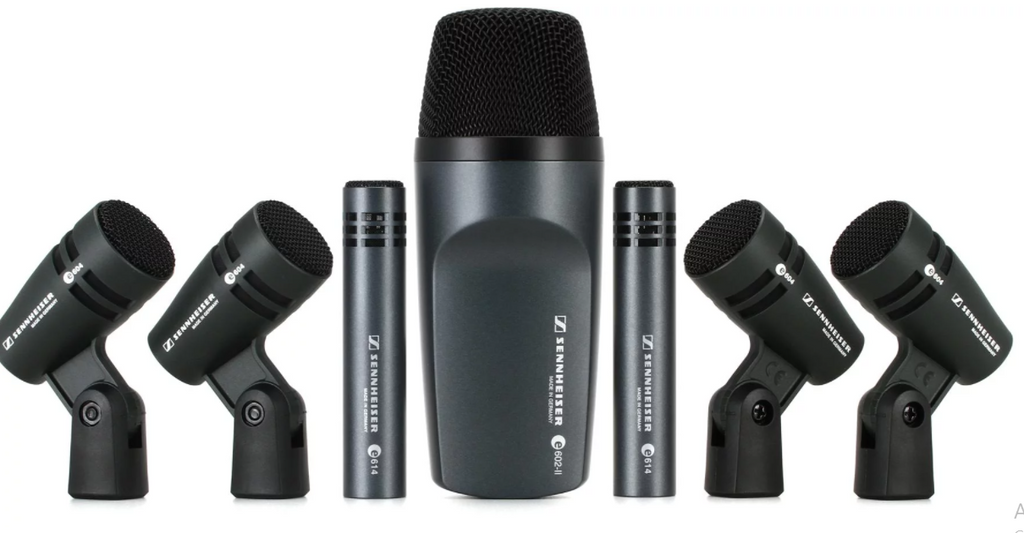
Nếu bạn ưa thích lựa chọn ở tầm trung mà không đặt quá nhiều trọng số vào khía cạnh chất lượng, dòng sản phẩm Sennheiser E600 sẽ phù hợp với bạn. Đây là một bộ sưu tập khá thông minh, bao gồm cả micro động và micro tụ điện, mà bạn có thể thường thấy khi nhận biết các bộ công cụ trống trực tiếp.
Trong bộ sản phẩm này, bạn sẽ được trang bị 4 micro E604 cho snare hoặc tom, micro kick E602E-II và một cặp micro điện dung E614. Một ưu điểm nữa của bộ này là giá treo vòng, giúp bạn dễ dàng kẹp micro vào trống. Những người chơi trống đã sử dụng bộ sưu tập này trong nhiều năm để điều chỉnh bộ công cụ trong tình huống biểu diễn trực tiếp, vì vậy nếu bạn quan tâm đến việc này, chắc chắn nên xem xét tùy chọn này.
Ưu điểm:
• Tùy chọn vị trí tốt
• Giải pháp mic tiêu chuẩn công nghiệp
Nhược điểm:
• Không có miếng đệm trên mic ngưng tụ
• Có thể có thể tìm thấy các tùy chọn tốt hơn ở cùng một mức giá
Lựa chọn hàng đầu mic trống là gì?
• Sự xuất sắc về chất lượng âm thanh: Earthworks DK7. Bộ mic này đảm bảo giá trị tối ưu cho khoản đầu tư của bạn, đảm nhận không chỉ về chất lượng mà còn cả tính thẩm mỹ và chất lượng âm thanh, Earthworks đã trang bị đầy đủ mọi khía cạnh cho bạn.
• Sự linh hoạt vượt trội: Sennheiser E600. Bộ sản phẩm này đem đến một sự lựa chọn tầm trung linh hoạt, hoạt động xuất sắc trong nhiều phong cách âm nhạc, kể cả rock và metal. Đây là lựa chọn hoàn hảo cho người mới bắt đầu, người trung cấp và ngay cả người chơi trống cao cấp.
• Bộ mic trống thân thiện ngân sách: Bộ trống Shure PGA 7. Bộ công cụ này đáp ứng cả nhu cầu của người mới bắt đầu và những người muốn ghi lại buổi luyện tập tại nhà của mình. Với bảy phần thiết yếu, bộ này có cấu hình mic tương tự như một số bộ công cụ cao cấp hơn.
Một số mẹo ghi âm Trống dành cho bạn.
Điều chỉnh trống trước mỗi phiên ghi âm là cực kỳ quan trọng. Điều này giúp bạn tránh phải thực hiện chỉnh sửa sau khi ghi âm và thao túng EQ sau này. Đặc biệt, việc điều chỉnh tom là vô cùng quan trọng, vì chúng thường được đánh giữa các khoảng thời gian khác nhau dựa trên số lượng trong bộ trống của bạn.
Khó khăn liên quan đến pha có thể gây phiền toái, nhưng cách tốt nhất để tránh chúng là tuân theo nguyên tắc 3:1 khi đánh trống. Điều này đề xuất rằng micro thứ hai của bạn nên được đặt cách micro thứ nhất ít nhất ba lần khoảng cách từ nguồn âm thanh.
Đặt mức tấn công và thời gian phân rã phù hợp trên cổng là điều cần thiết để đạt được sự cắn của trống mà bạn mong muốn. Một số kỹ sư thích thực hiện xử lý động trước khi cân bằng, trong khi người khác thích làm điều này sau. Để có sự kiểm soát tối đa trên âm thanh, hãy thử sử dụng cổng và bộ mở rộng trong chuỗi tín hiệu.
Dù bạn sử dụng EQ để cắt hoặc tăng cân bằng, hãy sử dụng nó để tìm ra các vùng âm thanh thiếu trong ghi âm của bạn, sau đó điều chỉnh chúng bằng cách tăng hoặc giảm tín hiệu.
Một trong những khía cạnh ít được đánh giá cao khi ghi âm trống là nén. Các loại nén phức tạp như nén trên đám mây và kỹ thuật nén đồng thời có thể giúp điều chỉnh độ động của ghi âm sau khi cân bằng phổ tần số bằng EQ. Điều này sẽ giúp tạo ra những chi tiết nhỏ để làm cho tiếng trống phong phú và trọn vẹn hơn.
Để tạo thêm chiều sâu và động cho ghi âm trống, bạn cần dựa vào nhiều loại hiệu ứng nền khác nhau, như bộ đệm hoặc phần mềm trong DAW của bạn. Bạn sẽ có thể nghe rõ sự phân rã của hiệu ứng nền riêng lẻ để tránh sự phối trộn không rõ ràng. Tuy nhiên, việc sử dụng quá nhiều hiệu ứng có thể ảnh hưởng tiêu cực đến kết quả cuối cùng, vì vậy hãy cẩn trọng.
Cần Bao Nhiêu Mic Để Thu Âm Trống?
Bạn có thể thu âm bộ trống với chất lượng cao bằng chỉ 2 đến 4 micro mà không gây tác động nhiều đến các yếu tố khác. Tuy vậy, trong một số trường hợp, bạn có thể cải thiện kết quả của mình thậm chí hơn nữa bằng cách sử dụng nhiều micro hơn tối đa từ 12 đến 16 micro).
Cách lý tưởng là bạn sẽ cần một micro động để thu âm trống bass và đặt nó cách đầu cộng hưởng của trống khoảng từ 6 đến 12 inch. Tiếp theo, bạn có thể sử dụng hai micro trên cao và đặt chúng cách snare khoảng 121cm và cách mặt sàn khoảng 15,2 cm. Thông qua cách này, bạn có thể ghi âm tiếng trống một cách trung thực, với âm trung tự nhiên và vòng cung âm trung đầy đặn, tương tự như âm thanh thực tế trong môi trường phòng.
Có càng nhiều micro trên bộ trống của bạn thì cơ hội thu thập chi tiết và đặc điểm tối ưu của trống càng cao. Đó là lý do tại sao sự lựa chọn của một bộ micro trống là sáng suốt đối với các người chơi trống, giúp bạn đạt được nhiều thành quả đáng kể chỉ với một khoản đầu tư.
Mic trống có cần nguồn Phantom không?
Mic condenser cần nguồn ảo 48v để hoạt động, mà thường được cung cấp thông qua bộ trộn hoặc thiết bị khuếch đại. Loại mic này chứa các thành phần điện tử hoạt động yêu cầu nguồn điện để hoạt động, trong khi micro động có cấu trúc thụ động và không cần nguồn điện ảo.
Có cần Micro trên cao không?
Để đơn giản, mic trên cao là loại mic được treo phía trên và thu âm toàn bộ âm thanh của bộ trống. Sử dụng micro trên cao giúp bạn bổ sung các yếu tố tinh tế vào âm thanh của mình trong quá trình xử lý sau thu âm.
Vị trí đóng vai trò quan trọng khi nói đến micro trên cao, nếu không, chúng có thể gây ra nhiễu loạn với các micro ở gần. Việc sử dụng mic ngưng tụ thường là lựa chọn thích hợp cho việc gắn trên cao.
Loại Mic nào Tốt nhất cho Trống?
Tùy thuộc vào loại trống bạn đang chơi, việc chọn micro sẽ thay đổi như sau:
Trống kick: Khi thu âm tiếng trống kick, bạn cần một micro có khả năng thu không gian và tạo cường độ tự nhiên cho âm bass. Neumann FET47 là một lựa chọn cổ điển dành cho trống bass, trong khi AKG 414 và Audio Technica 4033 cũng là các tùy chọn linh hoạt có thể được sử dụng trên nhiều phần khác.
Trống snare: Khi ghi âm trống snare, micro động là sự lựa chọn tốt. Shure SM57 luôn là ưa chuộng cho phần này, và micro EV RE10 và Lewitt 440 DM cũng được sử dụng rộng rãi. Đối với âm thanh mềm mại, Neumann KM84 và AKG 451 là các lựa chọn tụ điện hiệu quả.
Tom: Nếu bạn có nhiều trống tom và giá đỡ trong bộ trống, điều chỉnh từng tom riêng biệt có thể mang lại hiệu suất tốt. Tùy thuộc vào sở thích, bạn có thể thử cả micro động và micro tụ khi thu âm toms. Miktek PM11, Lewitt 340 TT và Sennheiser 421 là những lựa chọn đáng xem.
Micro trên cao: Phổ biến nhất là sử dụng một cặp micro trên cao treo phía trên trống. Cả micro tụ và micro dải băng đều tốt cho việc này. Một số lựa chọn hàng đầu bao gồm Miktek CV3, Roswell K47, AKG 451, Coles 4032 và Royer 121.
Micro phòng: Micro phòng giúp thêm tính thực tế và không gian vào âm thanh của trống, đặc biệt là khi bạn muốn âm thanh rộng lớn với nhiều hoạt động cấp thấp. Ban nhạc metal, rock và grunge thường sử dụng micro phòng để tạo cảm giác hứng khởi và sắc nét trong bản ghi của họ. Miktek C7, Marshall 2001, Lewitt LCT 640 và Altec M20 là một số lựa chọn phù hợp.
Mic trống nên để gần như thế nào?
Tùy thuộc vào âm lượng, tính chất và cường độ bạn cần, vị trí đặt micro sẽ khác nhau. Đối với âm thanh chính, bạn cần giữ micro của mình cách đầu ngoài từ 1 đến 3 inch. Trong trường hợp mic trong phòng hoặc trên cao, chúng thường được đặt cách bộ trống khoảng một mét.
Kết luận.
Khi đề cập đến việc thu âm trống, không có quy tắc cứng nhắc nào được áp đặt. Nỗ lực luyện tập trong nhiều năm và sự tinh tường trong việc lắng nghe là hai công cụ mạnh mẽ trong tài liệu của bạn. Khi thực hiện một cách đồng nhất, bạn sẽ có khả năng xác định những gì phù hợp nhất để thực hiện một hỗn hợp trống vững chắc.
Nếu bạn chưa quen với việc sử dụng micro trống, đừng lo lắng về việc đầu tư vào một bộ trang thiết bị đắt đỏ. Một bộ công cụ khởi đầu với giá cả hợp lý hơn, như Shure PGA Drum Kit 7, sẽ cung cấp tất cả các micro cần thiết để bắt đầu làm việc với âm thanh của bạn.
Tuy nhiên, nếu bạn là một người chơi trống có kinh nghiệm, bạn không thể bỏ qua sản phẩm ưa thích, Earthworks DK7. Dù bạn lựa chọn bất kỳ sản phẩm nào, hy vọng bạn sẽ rút ra nhiều kiến thức từ đó và tạo ra những âm thanh tuyệt vời với bộ mic trống mới của bạn.
